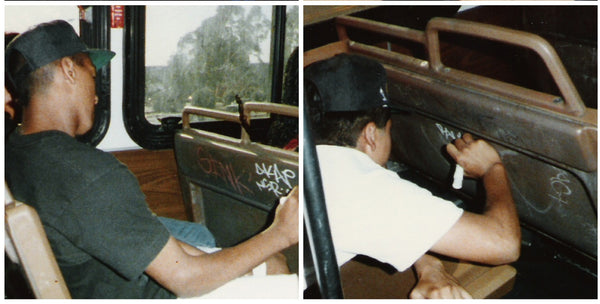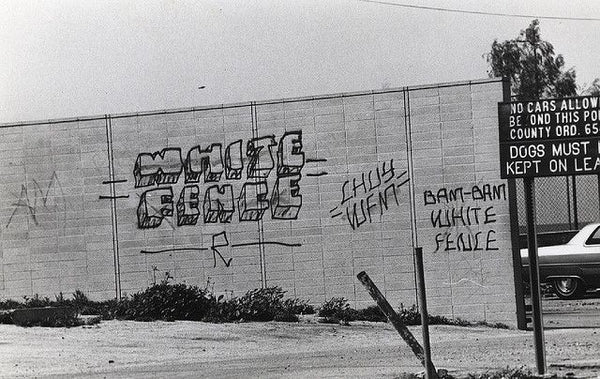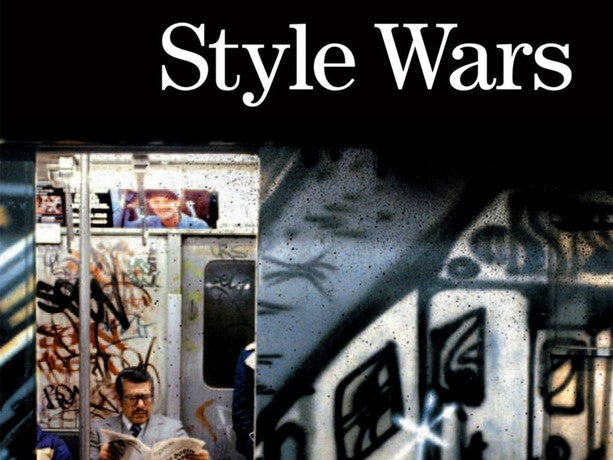While New York City usually is the first city that comes to mind as a graffiti epicenter, Los Angeles emerged as a graffiti hub in the 1980s before establishing a distinctive identity in the 1990s. While New York writers honed their chops on subway cars, Los Angeles writers used busses and concrete walls flanking the desolate L.A. river to express themselves. The street art reflected a unique blend of iconography from Spanish-speaking neighborhoods, Old English typeface and anthropomorphic lettering, pop art, and gang culture. With the rise of drugs and homicide rates in early-90s L.A., youth culture reached for a new visual language to express their discontent and mark their territory.

Mobbing Busses and Writing Along the L.A. River
In early-90s Los Angeles, the Rodney King beating and subsequent L.A. riots created a backdrop of racial tension. For young people feeling forgotten, angry, or marginalized, graffiti’s expressive power became a tool to push back. Just as their New York counterparts took to the public transportation system for its ease of access, the L.A. graffiti writers plastered the city’s RTD bus system with layer upon layer of tags.
While many of these artists used spray paint to scrawl fat letters across the sides and windshields in the dead of night, some took things in a more dangerous direction. As gangs sought to assert their territory, they brought guns to the buses, as well, provoking a strong police crackdown. At one point, the city’s police force even established a Ghost Bus armed with undercover cops ready to pounce on would-be taggers and those with more deadly intentions. According to a Los Angeles Times article in 1990, there were “3,000 taggers working in areas served by the RTD.”

The city’s river also emerged as one of the biggest and best venues for graffiti in the city. Fifty-one miles of river water run through the city of Los Angeles, most of it contained by desolate, concrete channels that rarely see police surveillance. The channels, sometimes bare and often abandoned, became a prime canvas for graffiti writers in the late 80s and early 90s. Writers like RISK had already inaugurated the river, overpasses, and other slabs of infrastructure as graffiti destinations in the 80s, but in the early 90s these sites exploded.



Emerging Graffiti Writers in L.A.
While many taggers remained nameless, a number of taggers deftly combined clean concepts and slick artistry to sett the tone for the 90s street art scene in Los Angeles. RISK and fellow writer OG SLICK, a Hawaii native who fused elements of Japanese and American culture in his work, energized the scene.

SLICK’s white-gloved hands, reminiscent of a certain Disney character’s gloves, became the signature motif in his designs. Both artists’ skillful street art attracted international acclaim, as they represented the U.S. at the International Street Art Competition in the late 80s.

RISK also joined forces with tagger RIVAL to form West Coast Artists, one of several crews in L.A. that aimed to cover buses, trains, and other modes of transportation in a rainbow of graffiti. RISK found success in the mainstream scene, too, lending his talents to projects for Ice Cube and Michael Jackson, among others.

In 1997, graffiti artist Saber crafted the largest graffiti wildstyle ever: his name, in blocky text, stretching out across the L.A. concrete riverbank. He took 35 nights to complete it. Another writer, CHAKA, tagged his name across the entire state of California throughout the 90s, with some reports estimating that he managed to tag over 10,000 public and private properties. Arrested countless times, CHAKA even tagged the elevator he took to meet with his probation officer.


Graffiti writers SKILL and SNAP, childhood friends with a shared love of street art, formed the ever-evolving group UTI Crew in the late 1980s. The group continues to thrive today not only in L.A. but in satellite locations across the country. They champion positivity and collaboration, and in doing so have amassed over 200 members. As the 90s progressed, the group represented an alternative to the territorial nature of gang-related tagging.

L.A.’s Latin-Influenced Graffiti Style
One of the more popular styles to emerge during the 90s in L.A. was the barrio style, which blends fine art references with pop culture influences and nods to Mexican Culture. Especially in Spanish-speaking areas of Los Angeles, this style thrived, with elaborate designs, punchy colors, and recurrent iconography such as lowriders and bikes. With the population of non-whites in Los Angeles nearly outnumbering the white population during the 90s, Latin cultural influences gave a distinctive look to the blossoming street art scene.


CHAZ, one of Los Angeles’ graffiti legends, borrowed not only from the East L.A. neighborhoods that he called home as a child, but from sources as varied as European typeface and Japanese calligraphy. Considered the “godfather of cholo style” according to Widewalls.com, Chaz has been writing his calligraphic work across L.A. since the 1970s.

His fusion of Latino gang influences and formal education at the Chouinard art school, including calligraphy training with Master Yun Chung Chiang results in a style distinctly his own. His “señor suerte” tag meshes places a fedora atop a skull with what looks like a fur collar around it. This became one of his best-known and most inspirational tags, especially for young writers coming of age in the 90s.

CHAZ’s calligraphic style references a number of sources, including East Asian calligraphy and Old English typeface, in large pat because of the sense of power and esteem that is associated with it. He explains in an interview, “It goes back to the first printing press, the Gutenberg, where the Germans used it to represent the government.” The style, known as cholo writing, is one that first gained visibility in the Mexican-American communities as far back as the 1940s, and one that continues to serve as a source of empowerment for writers today.


Contributions from the CBS Crew
Short for “Can’t Be Stopped,” CBS represents one of the most prolific graffiti crews in L.A. during the 1990s. Founded in the 1984 by Hex, Frost, Theory, and Demo, the crew’s evolving personnel has included members across racial and economic divides. Kids from Compton and Beverly Hills alike joined forces to artfully brand what had become a blighted landscape by the 1990s.

The moniker of Can’t Be Stopped was meant to serve as motivation to best the crew on the L.A. scene. The crew distanced itself from the violent territorialism seen in other crews, instead prioritizing art and camaraderie. Skate One, one of the CBS crew’s best-known members, is credited for pushing the crew’s development into a strong presence on the graffiti scene. Tragically, he died while trying to photograph his work in 1993, but the crew has persisted and remains a force today, thanks in large part to the strong familial bond among its members. The CBS crew is the subject of a 1997 documentary by member Cody Smith (aptly titled “Can’t Be Stopped”) which includes vintage footage, a history of the crew, and interviews with the artists.
Early 90's LA Graffiti Wrap Up...
The graffiti writers of Los Angeles needed only to look in their backyard – the bland concrete channels of the city’s river or the buses coasting down the roadways – to find a blank slate in the early 90s. While the significant problem of gang violence dominated the news headlines, the problems found a voice in spray-painted imagery. Groups of artists banded together, mimicking the crew mentality of L.A. gang culture and even leading to violent encounters with fellow graffiti crews or the police. Artists like CHAZ and RISK earned attention for their artistry and helped to build understanding for this artform that many were quick to peg as blight. They also opened the door for new ways of revitalizing abandoned areas, and what would eventually become a vibrant mural program in the city of Los Angeles.







Dert One AtD
February 24, 2021
Growing up in Atlanta in the 90’s I idolized Revok, Sever, Ceaze and Hense. These masters went on to LA to join with and help bring to notoriety the MSK and AWR crews, who in my opinion are at the top of the list of graffiti crews from the 90s to present.